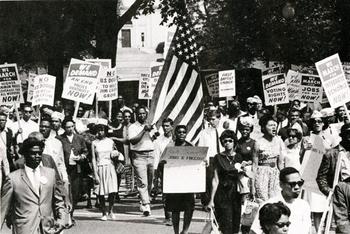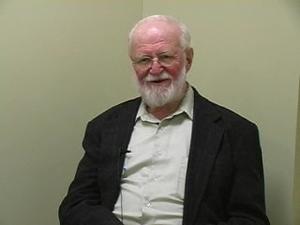
With the soon-to-be-dedicated Martin Luther King, Jr., Memorial along Washington, DC’s Tidal Basin, and the scheduled opening of the Smithsonian’s National Museum of African American History and Culture in 2015, some of Martin Luther King, Jr.’s dreams are becoming a reality. Let’s take a look back at the impact of this influential man and his ideas on the Smithsonian.

Smithsonian staff members, working in in the heart of the nation’s capital, witnessed the civil rights demonstrations of the 1960s, and were inspired by King’s vision for a more just America. In 1967, King and the Southern Christian Leadership Conference (SCLC) planned a “Poor People’s Campaign” to fight racism and poverty (see records about the "Poor People's Campaign from the Smithsonian). After King’s assassination in April of 1968, the SCLC decided to go forward with the campaign, and soon a village of tents and make-shift shelters, called Resurrection City, was set up near the Lincoln Memorial to house those people who came to Washington to demonstrate for social justice.

As Dr. Keith Melder, then curator of political history in the National Museum of History and Technology (now the National Museum of American History), recalled in an oral history interview conducted in 2006, “It rained and rained and rained. It rained, I think, almost every day for something like forty days. It rained, and the landscapes turned into mud and mire. And these poor people, they lived out here in the Resurrection City shelters. Somebody had designed a cheap shelter, not tents exactly, but plywood, tent-like structures, and they bedded down in these things, and they never got dry.” Smithsonian museums—their restrooms and restaurants, as well as exhibits—helped shelter Resurrection City residents from the wet spring and poor conditions. While there was debate within the Institution as to how the Smithsonian should respond—limit access to ensure no damage to the museums, or welcome a new audience—Secretary S. Dillon Ripley insisted that the doors stay open and trained the guard force to deal with demonstrators calmly, avoiding confrontation.

When Resurrection City residents were evicted from the outdoor site in mid-June by the National Park Service, Melder remembered, “We were able to salvage pieces of several of the shelters. I can remember going down. We got a Smithsonian truck, and I managed to corral some laborers from the labor force, and we simply went down and loaded the truck up with pieces of some of these shelters, and that was our collections for the Resurrection City. And those turned out to be valuable. They’re still occasionally displayed, and they’ve been on exhibition a number of times, and I don’t think anyone else preserved any residue of Resurrection City.”
Inspired by King’s 1963 “I Have a Dream” speech, Melder began to collect King memorabilia after his assasination and prepared a small display at the Smithsonian. But not all visitors accepted the new materials; Melder noted, “…some unknown person, visitor, came in and torched one of the objects on exhibition, a memorial banner to Martin Luther King, a handmade banner, and apparently lit a match to it. We didn’t have the kind of protection and security that we would do today, and they burned it up. I was . . . well, we were all, stunned….”

Produced by the Smithsonian Institution Archives. For copyright questions, please see the Terms of Use.

Leave a Comment